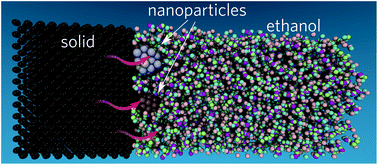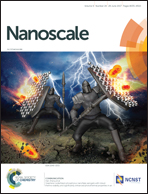Thermal transport at a solid–nanofluid interface: from increase of thermal resistance towards a shift of rapid boiling†
Abstract
We use molecular dynamics simulations to investigate interfacial thermal transport between an ethanol suspension containing gold atomic clusters and a gold surface, using both realistic and simplified molecular models of nanoparticles. The interfacial thermal conductance was determined via a thermal relaxation method for a variety of nanoparticle–nanoparticle and nanoparticle–surface interaction strengths. The Kapitza resistance is found to increase due to the presence of nanoparticles in the vicinity of the solid–liquid interface. The heat flow from the solid to the nanoparticles is separated from its counterpart from the solid to the liquid to discriminate their respective contribution to the total heat current. A per-vibrational-mode analysis highlights a shift of major heat carriers from low frequencies towards higher frequencies due to the coupling of the internal nanoparticle dynamics to the gold surface, in addition to stronger particle–surface interactions. Finally, we demonstrate that the increase of the Kapitza resistance significantly shifts the nanofluid/solid surface explosive boiling temperature to higher temperatures compared to pure ethanol.



 Please wait while we load your content...
Please wait while we load your content...